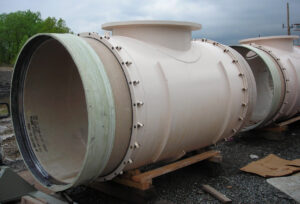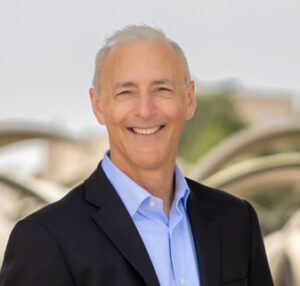Hobas Pipe USA Inc. is the leading North American producer and supplier of corrosion-resistant fiberglass pipe products for water- and wastewater-related infrastructure. Hobas’s pipe systems have a 150‑year design life, providing a solution for rehabilitating and replacing aging infrastructure. In this interview, Hobas CEO Martin Dana tells Municipal Water Leader about the company’s vision of providing sustainable solutions for future generations.
Municipal Water Leader: Please tell us about your background and how you came to be in your current position.
Martin Dana: In 2000, Northwest Pipe Company was recruiting for a regional sales manager for the water and wastewater markets for the Pacific Northwest. My wife and I decided to take the opportunity to relocate our family back to our home state. I held several leadership positions at Northwest Pipe in various capacities, including sales, operations, and business development. It was an exceptionally positive experience and I have the utmost respect for Northwest Pipe and my friends there. It was 22 years of learning about the manufacturing and selling of steel products and the pipe industry in general.
When Hobas was looking for a vice president of sales, I took the opportunity to re-examine my career and the products I had been associated with for over two decades and decided it was time to move in another direction. Making the move to Hobas has allowed me to offer something meaningful to the industry I love: a product with a 150‑year design life without any recurring costs for coatings, linings, and cathodic protection systems. That is a game changer for the water and wastewater markets.
Municipal Water Leader: Please introduce Hobas and tell us about its history.
Martin Dana: Hobas Pipe USA Inc. is owned by the Wietersdorfer Group, a 128‑year-old, fifth-generation family-owned business headquartered in Klagenfurt, Austria. Our U.S. presence started in 1987 with the opening of our headquarters and production facility in Houston, Texas. The technology we use to manufacture our pipe products was developed in the early 1960s in Europe.
For over 35 years, we have been manufacturing the highest-quality, longest-lasting fiberglass pipe for the gravity sewer market. We recently announced a $60 million, 5‑year capital expansion project that will allow us to offer the same benefits our wastewater customers have been enjoying for 35 years to the municipal water market. As part of this expansion, we will be increasing our production capacity by 50 percent and expanding our pressure pipe offerings from 12 inches to 120 inches for pressures up to 450 pounds per square inch. We are truly excited to bring our 150‑year-design-life products to the potable water market. Included in this capital expansion project are buildings, real estate, and production technology, and in 2021, we became the first U.S.‑based manufacturer of noncircular fiberglass shapes for sewer and storm water rehabilitation.
In a nutshell, we are North America’s leading producer of corrosion-resistant, fiberglass-reinforced pipe serving the water and wastewater markets. At Hobas, we strive to ensure that today’s infrastructure solutions do not become tomorrow’s problems.
Municipal Water Leader: What is the advantage of a corrosion-resistant product, and will you use the same materials for your new potable water products that you use for your sewer systems?

Martin Dana: We are offering a solution that will last for generations, making sustainability in pipe a reality. Our vision at Hobas is to provide peace of mind for future generations through safe and reliable infrastructure. Our potable water products will be made from the same material as our gravity sewer pipe. When we started, approximately 80 percent of our business involved the trenchless rehabilitation of corroding sewer systems. Today, our pipe is the product of choice for direct bury and rehabilitation of sewer systems due to its anticorrosion properties, light weight, leak-free joint system, and 150‑year design life. We ask other industry leaders to help us fulfill our vision by selecting and specifying fiberglass pipe for your water and wastewater projects. By doing so, we can prevent the need to rebuild our infrastructure 50, 100, or even 150 years from now. Imagine what other solutions this same money could be used for in the future—addressing major societal issues such as homelessness, poverty, education, and healthcare.
Municipal Water Leader: What services do you provide to your clients?

Martin Dana: We offer a range of services, from application engineering to installation assistance. Our application engineering service staff guide clients and contractors through the process of making the right pipe choice. If the project requires a specific installation method such as pipe jacking or microtunneling, our team ensures the pipe is designed to handle the installation process. Likewise, for the direct burial of either gravity or pressure projects, we ensure that our pipe is designed to handle the loads, depths, and pressures specified. In addition to our engineering expertise, we have a team of field service personnel dedicated to assisting our clients with the installation of our products. We do laminations and repairs and help the contractor in any way needed to ensure that we collectively deliver the best project possible to our municipal owners.
Municipal Water Leader: What effects is the Bipartisan Infrastructure Law having on your business?
Martin Dana: This law will lead to growing demand for both sewer and water projects, and as previously mentioned, Hobas is in the middle of a capital expansion program to ensure that we are able to further support our nation’s infrastructure programs. We believe that our products offer the best-in-class total cost of ownership when it comes to rebuilding the country’s infrastructure. We are passionate about our products and the long-term benefits they bring to the industry. It is time for our municipal leaders to rethink how they will spend the money to rebuild our communities. Let us think beyond the 50‑year horizon and learn from our past mistakes. Isn’t it time for us to leave a legacy for our children, grandchildren, and great-grandchildren that we can be proud of?
Municipal Water Leader: In addition to the durability of your products, does Hobas have any other sustainability initiatives?
Martin Dana: Absolutely. We are building a sustainable business model for the future, and everything we do is for the long term. That means we must be aware of the effects we have on our environment and constantly work toward reducing our impact. As part of our capital program, we will be installing over 7,000 photovoltaic panels capable of generating up to 2,500 kilowatts of direct current. The amount of carbon dioxide emissions offset by this project is equivalent to 2.5 million pounds of coal not burned and 514 cars not driven. This is a project most companies our size would not embark upon, but again, we believe in building a long-term sustainable business model that will last for generations.
In addition to this program, we launched an initiative to remove 100 internal-combustion-engine vehicles from the road by 2030. To accomplish this, we will be switching most of our company vehicles to electric, and we are offering a $5,000 incentive to our employees to switch from traditional internal-combustion-engine vehicles to electric vehicles.
Municipal Water Leader: In addition to your sustainability initiatives, what can you tell our readers about the direction you want to take Hobas in?
Martin Dana: We are in the process of transforming Hobas from a one-market, one-product factory into a multiple-product, multiple-market corporation. We are blessed with an exceptionally dedicated workforce. That dedication truly manifested itself in 2020. Our folks were dedicated to ensuring that the operation would not suffer any disruptions from the COVID‑19 pandemic, and we didn’t have any shutdowns, as so many other businesses did. As we modernize our equipment and streamline our processes, our challenge will be working as a team to achieve our goals. Everyone is going to have ideas for improvements, especially some of our most experienced people. We are going through a period of growth and change. Many of our people will have different responsibilities or even different jobs. Collaboration, communication, and patience are key.
We cannot accomplish our goals by just investing in equipment. We will need to invest in our people to help them grow. In 2020, when I took over as the CEO, one of the challenges we faced was the lack of human infrastructure to support our growth. We were not going to be able to achieve the type of growth we wanted without additional people. When I shared this with a close friend, he suggested I consider making the strategic position of vice president of legal and human resources one of my first hires. He relayed the story of his own career with Nike, in which he took on this role for one of Nike’s newly acquired companies, which at the time was about the size of Hobas. He explained that in this position, he was able to unburden his CEO of a variety of tasks and to help build up the organization to support the company’s revenue growth objectives. The result was a tremendous success.
To help Hobas better organize and move in the same direction, I have hired Dr. Daniel Schützenauer to be our vice president of legal, compliance, and human resources. Daniel comes from our parent company in Europe and brings a tremendous amount of talent to our team. He has already done a great job. As mentioned, our parent company has been in business for 128 years. There is much that can be learned from that, most importantly that your people are your most valuable asset. As CEO, my job is to make sure all our employees reach their full potential and fully contribute to our overall success.
Municipal Water Leader: What should every pipeline project planner or engineer know about Hobas?
Martin Dana: We are the leader in fiberglass pipe systems for water- and wastewater-related infrastructure. Our mission is to ensure that today’s solutions do not become tomorrow’s problems. We have a vision at Hobas to provide peace of mind for future generations by providing safe and reliable infrastructure. Every owner and engineer needs to understand that when they speak to Hobas, our interest is not just in selling pipe but in making sure that we provide sustainable solutions for future generations, because the greenest pipe is the one you never have to replace.
Martin Dana is CEO of Hobas Pipe USA Inc. He can be contacted at mdana@hobaspipe.com.

